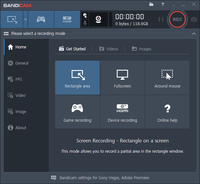Bandicam
Bandicam is a screen capture and screen recording utility originally developed by Bandisoft and later by Bandicam Company that can take screenshots or record screen changes.
 Bandicam Screen Recorder 4.0 screenshot | |
| Original author(s) | Bandisoft (2008 - 2016) |
|---|---|
| Developer(s) | Bandicam Company |
| Initial release | April 23, 2009 |
| Stable release | 4.5.0
/ October 23, 2011[1] |
| Operating system | Microsoft Windows |
| Available in | 50+ languages |
| Type | Screenshooting and screencasting |
| License | Shareware |
| Website | www |
Bandicam consists of three modes. One is the Screen Recording mode, which can be used for recording a certain area on the PC screen. The other is the Game Recording mode, which can record the target created in DirectX or OpenGL.[2] And the last is the Device Recording mode which records Webcams and HDMI devices.[3]
Bandicam displays an FPS count in the corner of the screen while the DirectX/OpenGL window is active mode. When the FPS count is shown in green, it means the program is ready to record, and when it starts recording, it changes the colour of the FPS count to red. The FPS count is not displayed when the program is recording in the Screen Recording mode. This software has a maximum frame rate of 120 FPS.[4]
Bandicam is shareware, meaning that it can be tested free of charge with limited functionality (It is often called crippleware). The free version of Bandicam places its name as a watermark at the top of every recorded video, and each recorded video is limited to 10 minutes in length.[5] However, users can adjust the screen margin with the video screen so that the watermark is off screen from the video.
The created video can be saved in AVI or MP4 formats.[6] Bandicam can also capture screenshots and save them as BMP, PNG, or JPG.[7] Bandicam features an autocomplete recording mode which can limit the video capture process to a specified size or time value.[8]
It supports hardware acceleration through Nvidia NVENC/HEVC, CUDA,[9] AMD APP[10] and Intel Quick Sync Video/HEVC.[11]
References
- Company, Bandicam. "Bandicam - Recording Software for screen, game and webcam capture". www.bandicam.com.
- "Easy Gameplay Capture with Bandicam" - Softpedia, April 9, 2011
- "Bandicam Screen Recorder Explained: Usage, Video and Download" - Softpedia, Jun 14, 2016
- "Bandicam 2.1.3 Review" - TopTenReviews, July 18, 2016
- "Best software for screen recording and video tutorials" - G2 Crowd, November 16, 2016
- "Bandicam Editors' Review" - Download.com staff, February 11, 2015
- "Record gaming on your desktop in HQ video" - Softonic
- "Record your desktop activity, gaming and working sessions with this powerful yet easy to use application, which features customizable recording options" - Softpedia, March 14, 2017
- "GeForce Forums - Can't use CUDA to convert videos anymore after 340.52 update!"
- "Bandicam (AMD APP) - AMD VCE 1440p Support - Community". community.amd.com.
- Company, Bandicam. "Bandicam - Recording Software for screen, game and webcam capture". www.bandicam.com.